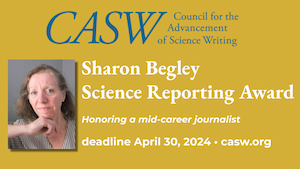ANOTHER YEAR. ANOTHER APOCALYPSE? Here we are after all, well into 2013 despite contemporary fantasies about the 2012 year-end world's end supposedly foretold by the Mayan calendar. Not that more potential apocalypses aren't said to be on the way, of course. Or at least spectacular shows.
And what are we to expect at the end of this year? A brilliant display from recently discovered Comet ISON. Michael Moyer has a brief description at SciAm's Observations. It's to be one of those once-in-a-civilization events. Bright as the full moon, blah-blah-blah. Those of us who were around for the big bust that was Comet Kohoutek at the end of 1973 advise caution. At Cosmic Log, Alan Boyle attempts to dampen expectations.
MEANWHILE, BACKWARD GLANCES AT SCIENTIFIC EVENTS OF 2012. Knight Science Journalism Tracker Charlie Petit collects a bunch of "Best of" lists from the likes of Science, Discover, Wired, Guardian, SciAm, etc., etc. You can probably work your way through them all by February or March.
MEDICAL DEVELOPMENTS AND HEALTH CARE IN 2012. The Institute of Medicine greeted 2013 yesterday by reporting that, although the US spends more on health care than any other country, our health is worse than that of any other rich country. The report's editors wrote a free summary for JAMA. At the NPR health blog Shots, Richard Knox also summarizes.
We also have much higher rates of death from drug addiction, auto accidents, and, oh yes, guns than any other country. But you knew that. For more bad news, get your own PDF copy of the report. It's free at the National Academies Press site.
At The Incidental Economist, Aaron Carroll brings you some of the IOM's scary country comparisons in chart form. Another Incidental, Austin Frakt, offers his list of ways to improve this disgusting record and links to other lists too. Lotsa luck.
TOP MEDICAL STORIES OF 2012. Journal Watch, a paywall publication from the New England Journal of Medicine that is written by clinicians for clinicians, has a New Year gift for you: free summaries of last year's top medical stories in several clinical fields.
For medical writers hoping for assignments that encourage colorful prose, gastroenterology provided some crappy opportunities. Perhaps most notable was dramatic cure of potentially fatal C. difficile infection via feces from a healthy donor. Not sure "donor" is the correct word in this context. This development, clinically very significant despite its comical aspects, did not, oddly, make it to the roundup on infectious disease top stories. That list included much about antibiotics, pro and con, and of course the contaminated epidural injections that caused meningitis.
A number of items in the roundup on women's health clinical news were about pregnancy and disorders of female plumbing — including a piece on robotic hysterectomy. I had missed the news from last spring about a study of the effects of providing free contraception to nearly 10,000 women in St. Louis between 2008 and 2010. The data are surely worth noting since free contraception, still controversial in some quarters, will be part of Obamacare. A majority of the women chose reversible methods that did not need daily attention, mostly the levonorgestrel IUD. The national abortion rate is 19.5/1000 women aged 15-44. Among study participants the rate was less than 7.5/1000. The national birth rate among girls 15-19 is 34.3/1000. Among teens in the study it was 6.3/1000. Here's the comment from Anne Moore, the nurse practitioner who edits Journal Watch Women's Health:
These findings from St. Louis demonstrate that we have the tools to forestall unintended pregnancy and induced abortion. The remaining question is whether or not our ever-evolving, politically influenced healthcare system will make highly effective reversible contraception broadly available.
Top news in pediatric and adolescent medicine included professional statements showing that circumcision is medically beneficial, the growing evidence that acetaminophen can contribute to asthma, and the perennial call for less prescribing of antibiotics. Psychiatry's greatest hits focus on new treatments, especially those for treatment-resistant cases of mental disorder.
Top stories in emergency medicine included some about the currently hot topic of head injuries. Find rash decisions — and news about skin cancer, psoriasis, and a growing list of pharma contributions — in the dermatology section.
HAVE A HEART. At CardioBrief, Larry Husten summarizes the American Heart Association's top 2012 research developments, which include saying no to sugary drinks. They had to wait until 2012? In another post, Husten explores the meaning of the enormous decline in early atherosclerosis over the past 60 years. See also Journal Watch's top ten list for cardiology.
CONCLUDING 2012. Susan Young's view of 2012 in biomedicine at Technology Review was all about genes and the brain. Topics: Cheaper gene sequencing, more commercial services for storing and analyzing the results, indirect analysis of fetal DNA, analysis of DNA in tumors, gene therapy continuing its creep onward, optogenetics, brain implants for cognitive function and control of artificial limbs, and continued lack of big advances for the continued explosion of Alzheimer's disease.
Technology Review also ran a series of pieces choosing several "Best of 2012" developments from the Physics arXiv blog and providing some detail on each. Kevin Bullis summarized the year in technology innovation. The editors chose a number of items about teleportation including a report on the teleportation distance record: 97 kilometers. And they did this, as far as I can tell, without once calling for Scotty to beam them up. Admirable restraint. The bottom line is that we seem to be on our way to satellite-based quantum communications and the quantum Internet.
HAPPY NEW YEAR. Enough nostalgia for 2012. Besides a comet rivaling the full moon, what do we have to look forward to in 2013?
We didn't quite jump off the fiscal cliff, but as Jeff Mervis points out at ScienceInsider, that's not particularly good news for science. Drastic automatic spending reductions, which could have cut 2500 research grants at the National Institutes of Health and 1500 at the National Science Foundation, have been delayed for a couple of months. But the fiscal cliff deal itself included unspecified cuts of $12 billion in discretionary spending over the next two years, with specifics left to Congress's discretion. The cuts are likely to include money for research. AAAS's Matt Hourihan considers some possibilities here; see the second item. For the long view, see Tech Review's graphic showing funding ups and downs for the past 50 years at 5 federal agencies.
LEAD, THE CRIMINAL ELEMENT. Do not fail to read Knight Science Journalism Tracker Deb Blum's consideration of blogger Kevin Drum's Mother Jones piece arguing that lead is a major contributor to the crime rate. See also the illuminating comments following Deb's post. Drum's piece was persuasive all right, but at The Crux, Scott Firestone says the science is still out.
At the Scholarly Kitchen, Kent Anderson heaps praise on Drum's piece as an example of the value of science writers: "those people who can tell a story based on disparate scientific insights, and generate valid, evidence-based education and behavioral or policy changes."
WHICH BRINGS US TO YEAR-END CONSIDERATION OF THE SCIENCE-BLOGGING PROFESSION. Get blogging wisdom from two of its czars. Victoria Costello, who runs the blog network at the Public Library of Science, lists ten essential qualities for science bloggers. And the redoubtable Bora Zivkovic, honcho of SciAm's blog network, shares "What I learned about science blogging/writing this year."
And don't miss Knight Science Journalism Tracker Paul Raeburn's piece about research on how the tone of blog comments can affect readers' judgments about the riskiness of the scientific findings under discussion. Scary. Paul says:
If that's true, bloggers and others who cover science online might want to change the way they treat comments. But the idea that managing comments can change readers' perception of a story opens the door to manipulation of comments in a way that we might find objectionable, even dangerous.
Indeed. But for some reassurance, see Matt Shipman's post at SciLogs.

.png)

